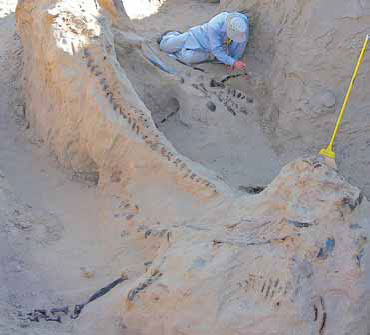Auction for rare dinosaur pair, not museum
|
Skeletons of what could be two new kinds of dinosaurs related to the T. rex and the Triceratops, excavated in 2006, will be offered for sale in November. CK Preparations |
Many paleontologists agree that two fossilized dinosaur skeletons found in Montana might be a major discovery.
The fossils apparently show two dinosaurs locked in mortal combat in a Cretaceous-era grave, an example of fighting that could provide a rare window into dinosaur behavior.
Perhaps more important, each may be a new kind of dinosaur - a Nanotyrannus lancensis, a type of pygmy T. rex, and a Chasmosaurine ceratopsian, a close relation of the Triceratops.
But scientists may never know for sure. These nearly complete skeletons, found by commercial prospectors on a private ranch, are not going directly to a museum for further study. Instead, billed as the "Montana dueling dinosaurs," they will be auctioned in November by Bonhams in New York, for a projected price of $7 million to $9 million. That would would be one of the highest prices ever paid for dinosaur fossils.
"This lines their pockets but hurts science," said Thomas Carr, the director of the Carthage Institute of Paleontology in Wisconsin. He was referring to the sellers, who include the owners of the ranch and the prospectors.
A museum could buy the fossils, or a private buyer could make them available to scientists. The United States restricts the collecting of fossils only on public lands.
Some experts say that high prices and loose restrictions encourage trespassing by some who poach on federal lands and illicitly smuggle from other fossil-rich countries, like Mongolia. At huge fossil fairs, prize specimens are on display from Mongolia, China and Russia.
"It is just stunning," said Hans-Dieter Sues, curator of vertebrate paleontology at the Smithsonian National Museum of Natural History in Washington. "You see entire dinosaur skeletons out of China, and dinosaur eggs. These things are for sale."
But many paleontologists acknowledge that there are commercial collectors who excavate sites with care. And private fossil hunters maintain that without their industry, many specimens would never be found.
The "dueling dinos" were discovered seven years ago in the Hell Creek formation, a fossil-rich trove of sedimentary rock underlying parts of Montana, Wyoming and North and South Dakota. Dinosaurs roamed there before their extinction about 65 million years ago.
Clayton Phipps, who calls himself the Dino Cowboy, remembers the day in June 2006 when he first dug up the tyrannosaur.
"I did a war whoop," said Mr. Phipps, 40, who has been hunting in Montana for 15 years.
The fossils were well preserved and articulated, with pockets of what could be fossilized skin attached, according to Peter L. Larson of the Black Hills Institute of Geological Research, a fossil dealer and expert in Hill City, South Dakota, who became involved with the finds in 2011.
Teeth from the tyrannosaur were embedded in the neck and back of the ceratopsian, he said, while the tyrannosaur's chest and skull were crushed as though the ceratopsian had delivered a kick. The fossils could settle long-running scientific debates over whether the pygmy tyrannosaur existed as a separate genus or was simply a juvenile T. rex, and whether it hunted as well as scavenged, Mr. Larson said.
Distinctive features of the fossil, including the relatively large size of its hands, a third finger and the shape of its wishbone, Mr. Larson said, meant there was "no doubt" it was a Nanotyrannus.
The ceratopsian might also be a new genus, he said, as shown by the unusual shape of its skull and pelvis and an additional horn - though he still holds out the possibility that it may be an example of an already described genus and species, Triceratops horridus.
Some specialists are skeptical about the claims the promoters are making. Just because the specimens were discovered side by side, for example, does not mean they were fighting.
Other experts worry their scientific worth may be lost.
"I don't think it is important at all because it was not collected as a scientific specimen," said Jack Horner of Montana State University, a longtime dinosaur paleontologist. "So in my book, it is worthless."
But Mr. Larson said that Mr. Phipps had excavated the fossils to the highest standard, including bringing them out of the ground in large chunks of earth so the context in which they were found could be studied later.
"I would put our skills up against any museum," he said.
Mr. Larson said he hoped that the fossils would eventually be bought by or donated to a museum. He said that their sheer size required institutional space.
He said, "It is so big, it seems unlikely it would go anywhere else."
The New York Times



















